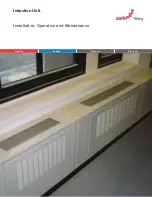
Heat recovery unit RDKS - Technical manual
10
FläktGroup DC_9295GB_20190326_R5
We reserve the right to make changes without prior notice
Clean the impeller housing and the fan blades with a brush or a vacuum cleaner.
NOTE! Take care not to damage any impeller housing balancers, and ensure
that no cables are trapped during reassembly.
Mo
de
LED
Par
am
.
Mo
de
LED
Par
am
.
MAINTENANCE AND CLEANING OF HEAT EXCHANGER AND FANS
Before cleaning the heat exchanger, fans etc., the unit should always have the power
disconnected.
CLEANING OF FANS
Note that the fans must not be cleaned with water or other fluids; they
may only be vacuum cleaned or brushed.
Remove the unit’s front cover (if there is one). Remove the screws on the door and
open the door. The picture shows a unit with right-hand configuration (RDKS-1).
Remove the heat exchanger package from the unit. Disconnect the electrical con-
nection to the impeller motor.
Vacuum clean the heat exchanger or blow clean with compressed air.
Disconnect the impeller from the fan housing by unscrewing the screws on the side
of the fan housing.
GENERAL
The fans, filters and heat exchanger are very important for the opera-
tion and economy of the unit. For this reason, it is crucial for them to
be kept clean and in good condition.
We recommend a general check-up every 6 months. For safety rea-
sons, general caution should be observed during maintenance of the
unit. Be careful to avoid trapping any cables. If necessary, use protec-
tive gloves.
CLEANING OF THE HEAT EXCHANGER
Check that the surface of the rotor is not coated with dust. Clean with
a vacuum cleaner or by blowing through with compressed air. If vac-
uum cleaning is not sufficient, hand-spray with grease dissolving fluid
and then blow clean with compressed air. Use the compressed air to
blow away from the clean side towards the dusty side.
Note! Water, acetone or similar solvents must not be used.
Remove the fan from the unit. Disconnect the electrical connection.
The drive belt and seals may need replacing due to wear and tear.
Check them for damage and replace if necessary. For designations,
see spare parts list on page 33.











































